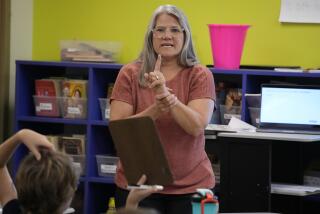Twice as Less: BLACK ENGLISH AND THE PERFORMANCE OF BLACK STUDENTS IN MATHEMATICS AND SCIENCE by Eleanor Wilson Orr (Norton: $15.95; 250 pp.)
- Share via
In the last few years, a continuing stream of national commissions and studies has delivered the bad news that American students seriously lag behind those of other industrial countries, especially Japan, in mathematics and science. Toyota may be doing for American education what Sputnik did in 1957--jolting Americans to the realization that Johnny can’t add.
The crisis is especially acute for minority students. Blacks and Latinos score below average on tests of mathematics and science achievement and are severely underrepresented in scientific and engineering fields. The roots of these persistent patterns are many, complex, and well documented, ranging from lower-quality schools and less encouragement from families and peer groups to larger social forces of poverty and discrimination affecting academic achievement.
This book by Eleanor Wilson Orr, a high school mathematics and science teacher, adds a curious and typically overlooked factor: that the grammar and syntax of black English can obstruct the mathematics learning of some black students. As founder and teacher at the Hawthorne School, a private coeducational high school in Washington, Orr dissected her students’ speech patterns under a microscope focused by more than 30 years of dedicated teaching. She practiced what recent education research has preached: that students’ errors are meaningful outcroppings of their thinking processes and not merely mistakes to be dismissed. “It was the incongruence of the obvious intelligence and determination of these students,” she writes, “with the unusual kinds of misunderstanding that persisted in their work that drove me to find answers.”
The book’s title, “Twice as Less,” represents a signal example of these “unusual kinds of misunderstanding.” For statements such as “The car traveling twice as fast would take twice as less hours to cover each mile,” Orr documents that the black English speaker’s confusion is more than a simple grammatical one. Instead of intending the standard English meaning of “half as many,” Orr shows that such students are not familiar with standard English forms denoting relationships involving multiplication and division, such as “three times as fast as.” Instead, they misinterpret many such phrases in terms of addition and subtraction. To them, “twice as less” can mean subtracting two, subtracting twice as much, and even, subtracting twice a number from itself.
What is most striking is that these semantic knots plague not just speakers of black English but the great majority of all students having difficulty in math and science. Too many students from all backgrounds fail to distinguish, for example, between appropriate uses for the four arithmetic operations, between location, direction, and distance, or between area and volume.
Ambiguity and abuse of the English language are often the culprits. The problem with word problems is the words. Unfortunate numbers of math and science classes, even in white suburban schools, are overly focused on recitation rather than reasoning; are enslaved to textbook drills rather than making use of hands-on, interactive materials; and reward parroting of phrases found in the text or uttered by the teacher. The result is that American students learn to make, in one researcher’s phrase, “noises that sound scientific,” but which belie any real conceptual learning.
Orr has a revealing story to tell, but the storyline gets muddled through 200 pages of dissertation on the numerous confusions arising from black English interpretations of prepositions, conjunctions, and relative pronouns vital in expressing mathematical relationships (e.g., divide 10 by two, divide two into 10).
At times, Orr’s explanations of the students’ convoluted reasoning are themselves hard to follow (e.g., “To her (the student), ‘the slower train is covering twice that of the faster train.’ And since the faster train’s speed is three m.p.h. less than half that of the slower, the slower train’s speed must be three m.p.h. more than twice that of the faster: This must be so because when one quantity is half of another, the second is twice the first, and when one quantity is three less than another, the second is three more than the first. . . .”)
Perhaps a more technical audience of psycholinguists will appreciate this level of detail, but the more general reader, like this one, will want less exposition of symptoms and more attention to cure. In the afterword, Orr finally but briefly turns to some solutions, responding to “two questions I am always asked: What can be done? What did you do at Hawthorne?” She tells of one student, Mary, who had trouble with fractions and geometry proofs in her first high school math courses. Two years later, however, she gave a masterful account of how the 19th-Century British scientist, John Dalton, reasoned about the volumes of gases and atomic structure.
What happened in those two years? How did Mary’s learning develop? How did the Hawthorne teachers work with her and whet her appetite for more? Mary, we learn, completed high school and went on to college, but a more detailed case study of Mary’s and other students’ progress would have enriched this book and given it a more human dimension.
Orr ends with a few examples of effective teaching--lessons in fractions where students drew visual diagrams rather than memorize words, simulations of Newton’s experiments in optics using geometric constructions. We need an encyclopedia full of such teaching techniques. Perhaps that will be Orr’s next work. For now, this book serves to remind us that students are more similar than they are different and that each of them--every Johnny and Mary--deserves a better chance at knowing the pleasures of mathematics and science.
More to Read
Sign up for Essential California
The most important California stories and recommendations in your inbox every morning.
You may occasionally receive promotional content from the Los Angeles Times.













